Canton of Vaud
The canton of Vaud (/voʊ/ VOH; French: canton de Vaud, pronounced [kɑ̃tɔ̃ də vo];[3][4][5] German: Waadt, pronounced [vat] (![]()
Vaud Waadt | |
|---|---|
| Canton of Vaud Canton de Vaud (French) | |
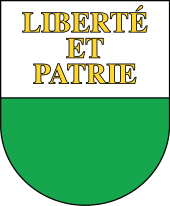 Coat of arms | |
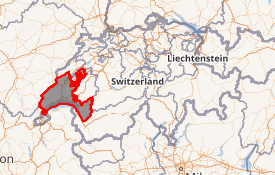
Location in Switzerland
Map of Vaud 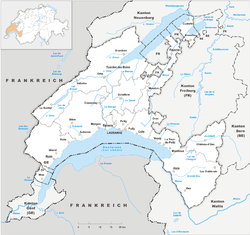 | |
| Coordinates: 46°37′N 6°33′E | |
| Capital and largest city | Lausanne |
| Subdivisions | 339 municipalities, 10 districts |
| Government | |
| • Executive | Conseil d’État (7) |
| • Legislative | Grand Council (150) |
| Area | |
| • Total | 3,211.94 km2 (1,240.14 sq mi) |
| Population (December 2018)[2] | |
| • Total | 799,145 |
| • Density | 250/km2 (640/sq mi) |
| ISO 3166 code | CH-VD |
| Highest point | 3,210 m (10,531 ft): Diablerets |
| Lowest point | 372 m (1,220 ft): Lake Leman |
| Joined | 1803 |
| Languages | French |
| Website | www |
The capital and biggest city is Lausanne, officially designated "Olympic Capital"[6] by the International Olympic Committee and hosting many international sports organizations. Other main cities are Yverdon-les-Bains and Montreux. As of 2018 the canton has a population of 799,145.[2]
History
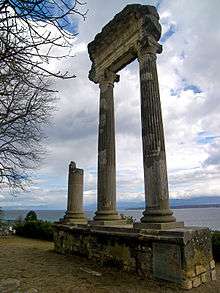
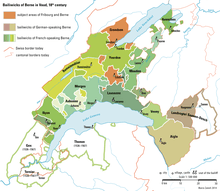
Humans lived alongside the Vaud lakes in prehistoric times. Later, the Celtic tribe of the Helvetii inhabited the area. Caesar's troops defeated the Helvetii in 58 BC and as a consequence the Romans settled in the area. The many towns established by the Romans include Vevey (Latin: Viviscus) and Lausanne (Lausonium or Lausonna).
In 27 BC the state of Civitas Helvetiorum was established around the capital of Avenches (Aventicum). There are still many Roman remains around the town today. Between the 2nd and the 4th centuries Alemannic tribes repeatedly invaded the area, and in the 5th century the Burgundians occupied the territory. The Merovingian Franks later replaced the Burgundians. Their control did not last long either, and in 888 the area of the canton of Vaud became part of the Carolingian Empire (the successor state to the Merovingians). In 1032 the Zähringens of Germany defeated the Burgundians. The Zähringens themselves were succeeded in 1218 by the counts of Savoy. It was only under the counts of Savoy that the area gained political unity as the Barony of Vaud. A part stretching from Attalens to the River Sarine, in the north, was absorbed by the canton of Fribourg.
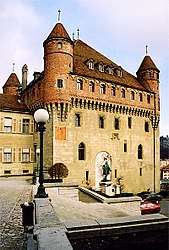
As the power of the House of Savoy declined at the beginning of the 15th century, troops from Bern occupied the land. By 1536 Bern had completely annexed the area. Vaud's Protestant Reformation started with co-workers of John Calvin like Pierre Viret (a famous debate took place at the cathedral of Lausanne), but it was only decisively implemented when Bern put its full force behind it.
The Bernese occupiers were not popular amongst the population. In 1723 Major Abraham Davel led a revolt against Bern, in protest at what he saw as the denial of political rights of the French-speaking Vaudois by the German-speaking Bernese; he was subsequently beheaded.[7] Later, inspired by the French Revolution of 1789–1799, the Vaudois drove out the Bernese governor in 1798 and declared the Lemanic Republic. Vaud nationalists like Frédéric-César de La Harpe had called for French intervention in liberating the area, and French Revolutionary troops moved in, taking over the whole of Switzerland itself in the process and setting up the Helvetic Republic. Under Napoleon I (Emperor 1804-1815), Vaud became (1798-1803) the canton of Léman. Unrest about the abolition of feudal rights and taxes led to increased discontent, which culminated in the revolt of the Bourla-papey in spring 1802, closely followed by the Stecklikrieg (August to October, 1802) that brought the end of the entire Helvetic Republic in 1803. In 1803 Vaud joined the re-installed Swiss Confederation. In spite of Bernese attempts to reclaim Vaud, it has remained a sovereign canton ever since.
In the 19th century, the canton of Vaud was an outspoken opponent of the Sonderbund Catholic separatist movement, which led to intervention by 99,000 Swiss Federal troops under General Henri Dufour against 79,000 separatists, in the Sonderbund War (November 1847). Separation was prevented at the cost of very few lives.
The current cantonal constitution dates from 14 April 2003, replacing the constitution of 1885.[8]
Geography



The canton stretches from Lake Neuchâtel in the north, where it borders the canton of Neuchâtel, to Lake Geneva (French: Léman) in the south, where it borders the canton of Geneva, the French department of Haute-Savoie (lake border) and the canton of Valais (Chablais). In the Jura mountains in the west, the canton borders the French departments of Ain, Jura, and Doubs. In the east, it borders the cantons of Fribourg and Bern. The total area is 3,212 square kilometres (1,240 sq mi).
Along with the canton of Berne, Vaud is one of the two cantons whose territory extends from the Jura to the Alps, through the three distinct geographic regions of Switzerland.
The areas in the south east are mountainous, situated on the north side of the Bernese Alps. This region is commonly named the Vaud Alps (French: Alpes Vaudoises). The Diablerets massif, peaking at 3,210 metres (10,531 ft), is the highest mountain of the canton. Other summits such as the Grand Muveran and the Tour d'Aï are visible from most of the canton. The area also hosts several popular skiing destinations such as Villars, Les Diablerets and Leysin.
The central area of the canton, in contrast, consists of moraines and is hilly. There are plains along the lakes. In the north, Avenches is in an exclave of the canton surrounded by the canton of Fribourg and Lake Neuchâtel. On the other hand, there are three enclaves of the canton of Fribourg (Estavayer-le-lac, Vuissens, Surpierre), as well as two enclaves of the canton of Geneva (Céligny), that are surrounded by the canton of Vaud.[9]
The north-western part of the canton is also mountainous but in a more modest way with mountains generally not above 1,500 metres (4,900 ft); the Jura Mountains. The Vallée de Joux is one of the most popular destinations in the region and also a centre of luxury mechanical Swiss watch manufacturing.[10]
Politics

Members of the national council
Source:[11]
| UDC members | PS members | PES members | PLR members | PDC members | PVL member(s) |
|---|---|---|---|---|---|
| Michaël Buffat | Cesla Amarelle | Daniel Brélaz | Frédéric Borloz | Claude Béglé | Isabelle Chevalley |
| Alice Glauser-Zufferey | Ada Marra | Adèle Thorens | Fathi Derder | --- | --- |
| Jean-Pierre Grin | Roger Nordmann | --- | Olivier Feller | --- | --- |
| Jacques Nicolet | Rebecca Ana Ruiz | --- | Isabelle Moret | --- | --- |
| --- | Jean Christophe Schwaab | --- | Laurent Wehrli | --- | --- |
Members of the council of states
Source:[12]
| PS member(s) | PLR member(s) |
|---|---|
| Géraldine Savary | Olivier Français |
Federal election results
| Percentage of the total vote per party in the canton in the National Council Elections 1971–2015[13] | ||||||||||||||
|---|---|---|---|---|---|---|---|---|---|---|---|---|---|---|
| Party | Ideology | 1971 | 1975 | 1979 | 1983 | 1987 | 1991 | 1995 | 1999 | 2003 | 2007 | 2011 | 2015 | |
| FDP.The Liberalsa | Classical liberalism | 26.0 | 25.6 | 27.1 | 30.4 | 27.6 | 26.4 | 23.5 | 25.0 | 18.5 | 14.6 | 16.3 | 26.8 | |
| CVP/PDC/PPD/PCD | Christian democracy | 5.3 | 4.6 | 5.1 | 4.5 | 4.1 | 3.6 | 5.6 | 4.5 | 4.4 | 5.6 | 4.6 | 4.1 | |
| SP/PS | Social democracy | 25.0 | 27.6 | 24.9 | 21.9 | 22.5 | 22.9 | 22.7 | 22.4 | 21.7 | 22.0 | 25.2 | 22.2 | |
| SVP/UDC | Swiss nationalism | 7.7 | 8.0 | 6.8 | 6.2 | 6.2 | 7.3 | 7.8 | 10.7 | 20.3 | 22.4 | 22.9 | 22.6 | |
| LPS/PLS | Swiss Liberal | 12.4 | 13.6 | 16.7 | 16.9 | 17.4 | 17.6 | 14.7 | 12.6 | 11.1 | 8.1 | 5.7 | c | |
| Ring of Independents | Social liberalism | 4.1 | 1.6 | 0.8 | * b | * | 0.9 | * | * | * | * | * | * | |
| EVP/PEV | Christian democracy | * | * | * | * | * | * | * | * | 0.7 | 1.1 | 1.1 | 1.1 | |
| GLP/PVL | Green liberalism | * | * | * | * | * | * | * | * | * | * | 5.1 | 3.9 | |
| BDP/PBD | Conservatism | * | * | * | * | * | * | * | * | * | * | 0.8 | 1.8 | |
| PdA/PST-POP/PC/PSL | Socialism | 12.2 | 10.7 | 9.3 | 4.1 | 3.5 | 4.2 | 8.9 | 7.8 | 6.7 | 4.7 | 2.1 | * | |
| GPS/PES | Green politics | * | 1.0 | 6.4 | 7.0 | 8.4 | 6.3 | 4.1 | 7.1 | 11.3 | 14.3 | 11.6 | 11.3 | |
| FGA | Feminist | * | * | * | 3.8 | 3.7 | 3.6 | 2.6 | * | * | * | * | * | |
| Solidarity | Anti-capitalism | * | * | * | * | * | * | 2.6 | 2.1 | 2.6 | 2.1 | 1.8 | 2.9 | |
| SD/DS | National conservatism | 4.2 | 1.6 | * | 2.6 | 2.8 | 2.9 | 1.8 | 0.9 | 0.3 | 0.2 | 0.1 | 0.1 | |
| Rep. | Right-wing populism | 2.9 | 3.1 | * | * | * | * | * | * | * | * | * | * | |
| EDU/UDF | Christian right | * | 1.0 | * | * | 1.1 | * | 2.7 | 2.7 | 1.8 | 1.3 | 1.1 | 0.7 | |
| FPS/PSL | Right-wing populism | * | * | * | * | * | 2.5 | * | * | * | * | * | 0.0 | |
| MCR | Right-wing populism | * | * | * | * | * | * | * | * | * | * | 0.5 | * | |
| Other | * | 1.6 | 2.9 | 2.6 | 2.8 | 1.9 | 3.1 | 4.2 | 0.5 | 3.7 | 1.1 | 2.6 | ||
| Voter participation % | 45.9 | 43.5 | 37.3 | 40.2 | 37.4 | 37.4 | 32.9 | 31.5 | 42.7 | 44.3 | 41.6 | 42.9 | ||
Political subdivisions
Districts
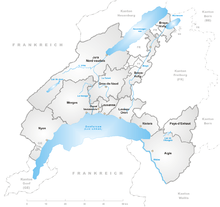
The canton of Vaud is divided into 10 districts:
- Aigle with capital Aigle
- Broye-Vully with capital Payerne
- Gros-de-Vaud with capital Échallens
- Jura-Nord vaudois with capital Yverdon-les-Bains
- Lausanne with capital Lausanne
- Lavaux-Oron with capital Cully
- Morges with capital Morges
- Nyon with capital Nyon
- Riviera-Pays-d'Enhaut with capital Vevey
- Ouest Lausannois with capital Renens
Municipalities
There are 376 municipalities in the canton (As of 2008).
Demographics
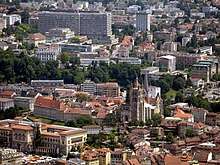
The population is French-speaking and historically was mostly Protestant (Calvinist), dating from the early years of the Reformation. Recently, however, this has been changing due to immigration from Southern Europe. In 2000, the population was nearly evenly split between Protestants (40%) and Roman Catholics (34%).[14]
The population of the canton (as of 31 December 2018) was 799,145.[2] As of 2010, the population included about 28% foreigners, including many Italians.[15] The major population centres of the canton are: Lausanne (139,111 inhabitants in 31 December 2018), Montreux-Vevey (Montreux: 25984 Vevey:19891 inhabitants) and Yverdon-les-Bains (30,157 inhabitants). The region around Nyon is often considered part of the agglomeration of Geneva. All of these are on Lake Geneva (called Lac Léman in French), except for Yverdon, which is on Lake Neuchâtel.
Economy
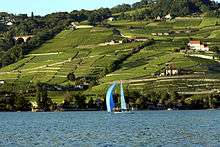
The capital, Lausanne, is the major city of the canton. There are light industries concentrated around it. In 1998, 71.7% of the workers worked in the tertiary sector and 20.8% in the secondary.
The canton is the second-largest producer of wine in Switzerland. Most of the wine produced in the canton is white, and most vineyards are located on the steep shores of Lake Geneva such as the UNESCO World Heritage Site the Lavaux Vineyard Terraces. There is agriculture in the areas away from Lake Geneva. Sugar beet is important around Orbe, tobacco in La Broye Valley, and fruit at the foot of the Jura mountains. Cattle breeding and pasture are common in the Alps and the Jura mountains. There is a salt mine at Bex. Tourism is important in many towns along Lake Geneva. Major lakeside resorts include Lausanne, Montreux, and Vevey.
The Union Cycliste Internationale is based in Aigle, and many of its defamation lawsuits against critics have been heard in the Est Vaudois district court of Vevey.[16]
Education
Two Swiss public universities are located within the canton:
- Swiss Federal Institute of Technology in Lausanne (EPFL)
- University of Lausanne (UNIL)
Additionally, there are several public hautes écoles offering a limited selection of programmes:
- Haute école d'art et de design (ECAL)
- Vaud School of Business and Engineering (HEIG-VD)
- University of Applied Sciences and Arts Western Switzerland (HES-SO)
- Haute École de Santé La Source (HEdS-La Source)
- Haute École de travail social et de la santé (EESP)
- École hôtelière de Lausanne (EHL)
- Changins
- Haute école des arts et de la scène (Manufacture)
- Haute École de Santé Vaud (HESAV)
- Haute école de musique (HEMU)
- Haute école pédagogique du Canton de Vaud (HEP Vaud)
Local cuisine
Taillé aux greubons are a salted bakery specialty of the region consisting of crackling encased in puff pastry. Another of the canton's specialties is carac, a pastry made of pie crust filled with chocolate ganache, covered by a characteristic green frangipane layer, and topped with a dot of chocolate.[17]
Notes and references
- Arealstatistik Land Cover - Kantone und Grossregionen nach 6 Hauptbereichen accessed 27 October 2017
- Swiss Federal Statistical Office - STAT-TAB, online database – Ständige und nichtständige Wohnbevölkerung nach institutionellen Gliederungen, Geburtsort und Staatsangehörigkeit (in German) accessed 23 September 2019
- "Le français est la "langue officielle" du canton de Vaud..." Retrieved 2016-08-08.
- "Canton de Vaud (Confédération suisse)". Retrieved 2016-08-08.
- "Article 3 : Langue officielle". Retrieved 2016-08-08.
- "Lausanne Olympic Capital". 2012. Retrieved 2012-12-17.
- Histoire de la Suisse, Éditions Fragnière, Fribourg, Switzerland.
- "Les 10 ans de la constitution: Canton de Vaud : site officiel". Vd.ch. Retrieved 2014-05-03.
- "Vaud.ch - Bienvenue dans le canton de Vaud".
- "Archived copy". Archived from the original on 2009-07-24. Retrieved 2009-06-26.CS1 maint: archived copy as title (link)
- The Swiss Parliament. "Members of the National Council: Canton of Vaud". Retrieved 2017-04-06.
- The Swiss Parliament. "Members of the Council of States: Canton of Vaud". Retrieved 2017-04-06.
- Nationalratswahlen: Stärke der Parteien nach Kantonen (Schweiz = 100%) (Report). Swiss Federal Statistical Office. 2015. Archived from the original on 2016-08-02. Retrieved 2016-08-08.
- Federal Department of Statistics (2004). "Wohnbevölkerung nach Religion". Archived from the original (Interactive Map) on 2016-09-24. Retrieved 2009-01-15.
- Canton de Vaud (2010). "International website for the promotion of the canton of Vaud - Population and social life". Retrieved May 23, 2010.
- Vaughters defends Kimmage ahead of UCI case, Daniel Benson, cyclingnews.com, September 28, 2012
- "Carac". www.patrimoineculinaire.ch (in French). Retrieved 29 July 2019.
Bibliography
- (in French) Laurent Flutsch and Séverine André (with the collaboration of Bernadette Gross), Y en a point comme nous. Un portrait des Vaudois aujourd'hui [There are none like us. A portrait of the Vaudois of today], Éditions Infolio, 2015, 368 pages (ISBN 9782884747615).
External links
| Wikimedia Commons has media related to Canton of Vaud. |
